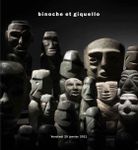On Friday January 29th, Binoche et Giquello will orchestrate its first pre-Columbian art sale of the season, assisted by Mezcala Expertises.
Before Teotihuacán
These standing, upright, proud-looking figures have faces that are never quite all the same nor ever quite different. They laid the foundations of what evolved into the brilliant Teotihuacán civilization, and inklings of the canons of this art blessed by the gods can be found here. The figures are small yet give the impression of being monumental in size, their arms and open palms outstretched in a gesture of offering. They were a first step towards realism, although hieratic poses still predominate. No temples were built in Guerrero and the works found are far from revealing all of this culture’s secrets—the mystery surrounding them undeniably adds to their appeal. In January 1992 Jacques Blazy, the auction’s expert, held the first show devoted to these pure-lined works, "Stone Figures: Guerrero Art in Pre-Colombian Mexico", at the Seita Museum-Gallery, a pioneering institution. This piece was acquired in the late 1960s at New York’s Merrin Gallery, a reference in Pre-Colombian art. It comes from a French private collection, one of the world’s most important for Guerrero cultures. Both of these factors, in addition to the work’s stylistic qualities, mean it can serenely await the verdict of the bidding.
|






